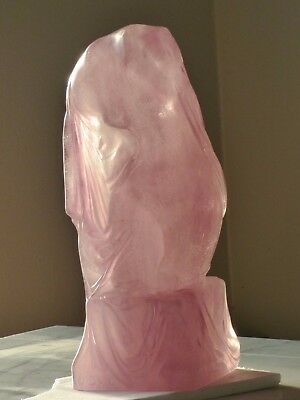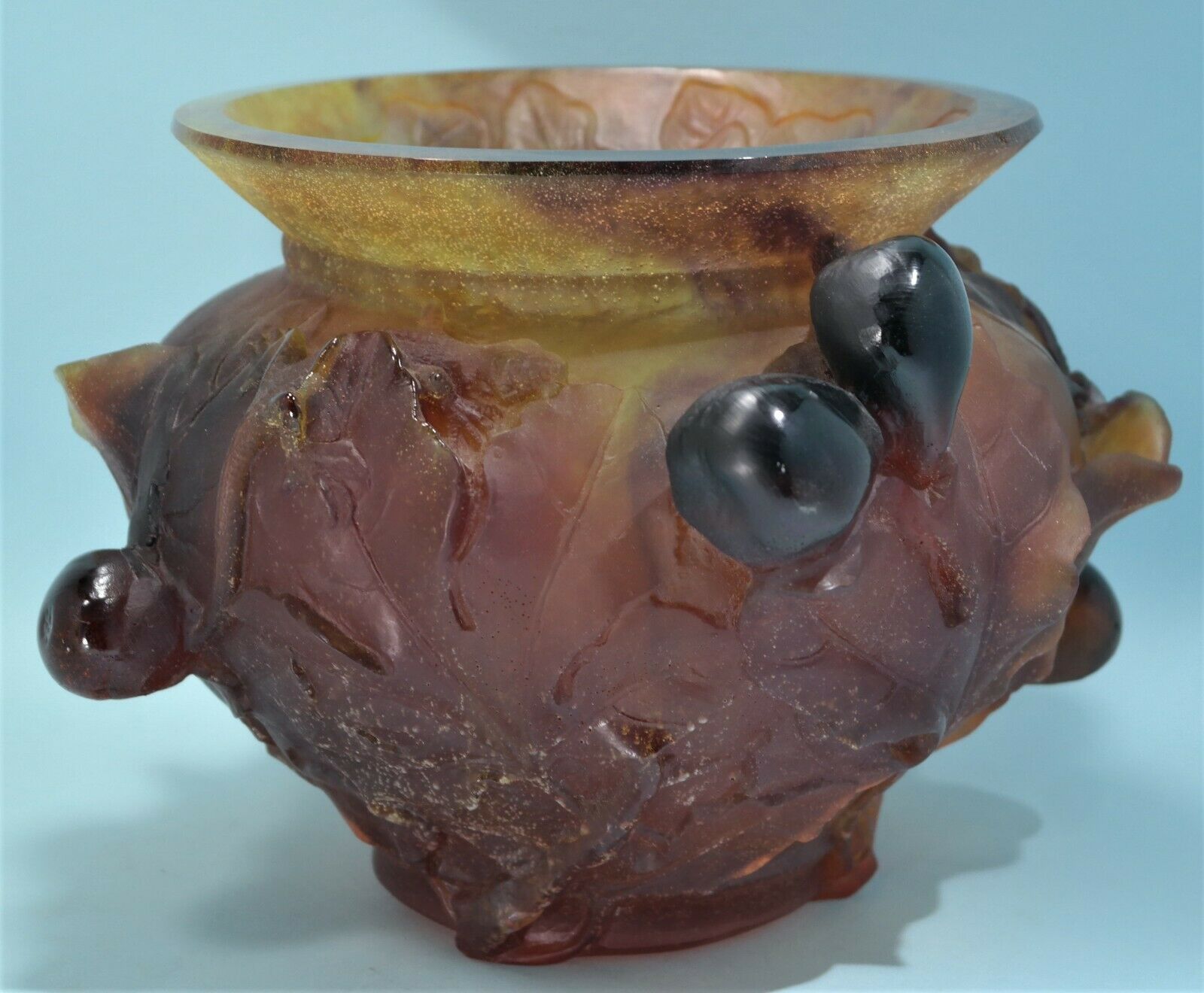-40%
RARE DAUM PATE DE VERRE ART DECO XL Sculpture Draped Aphrodite limited 1975
$ 1581.36
- Description
- Size Guide
Description
This rare neoclassical style PATE DE VERRE sculpture was CREATED AS A VERY LIMITED EDITION from original work of RENOWNED French sculptor OLIVIER BRICE IN 1975 FRANCE . LIMITED To only 75 worldwide . SIGNED IN HIGH RELIEF WITH BOTH THE ARTIST'S NAME AND DAUM France , NUMBERED ON THE BOTTOM as 75 - the last of the limited edition . AMETHYST COLOR is dominant . Monumental in size - 16 1/2" TALL , WEIGHS 38 + POUNDS ! It has a lot of classical appeal and very impressive because of it's large size .Glittering trapped air
bubbles inside of the glass give appearance of amethyst cascade ....
Free shipping within USA ONLY .
I ship via express mail and pack with Great care . This beautiful item will make great addition to your house decor . Do not hesitate to E mail questions OK Daum is a crystal studio based in Nancy, France, founded in 1878 by Jean Daum. His sons, Auguste Daum and Antonin Daum, oversaw its growth during the burgeoning Art Nouveau period. Currently Daum is the only commercial crystal manufacturer employing the pâte de verre (glass paste) process for art glass and crystal sculptures, a technique in which crushed glass is packed into a refractory mould and then fused in a kiln. During the Universal Exhibition of 1900 Daum was awarded a ‘Grand Prix’ medal. Daum glass became more elaborate, acid etching was often combined with carving, enamelling and engraving on a single piece of glass to produce creative glass master-pieces. The most complicated creations also feature applied glass elements, such as handles and ornamental motifs in naturalistic forms. The Daum brothers quickly moved on to become one of the major forces in the Art Nouveau movement, seriously rivalling Gallé, so much so that when Émile Gallé died in 1904 they became the leaders in the field of decorative glass. Since 1878 Daum have been crafting world - renowned beauty in crystal using rare and ancient techniques. Daum´s perfect mastery of pate de verre has earned it a worldwide reputation for excellence. The artisans at Daum are able to capture both fine details and subtle contouring, and each glass sculpture will radiate with light and color, making it a beautiful addition to any home, and the perfect gift. Every single Daum crystal piece has it´s own individuality as they are hand made. No two Daum crystals are exactly alike ! A Short History of Pate de Verre Pate de verre, the name bestowed by the French in the late 19th century and by which we know the technique today, is one of the oldest known forms of glass working. Ancient Mesopotamian cuneiform texts dating back to the early 2nd millennium BCE describe their methods of working glass. Glass was treated as a special material, and valued accordingly, as inlays in jewelry and sculpture and other art objects. Because of the time and techniques involved in kiln casting; i.e. model making, mold making, preparing the glass, filling the mold, kiln firing, and cleaning and polishing; kiln cast glass was prized. One Egyptian name for it is 'Stone that Flows'.While the Mesopotamians are the earliest known culture to have developed glass forming techniques, Egyptians quickly added to the body of knowledge. These techniques first flowered around 1500 - 1000 BCE. Intricate mosaic style vessel forms dating as far back as 1500 BCE have been discovered. These arts went into decline only to be revived in the 9th century BCE by Egyptian and Assyrian glass artists. In the 4th and 5th centuries, the Persians produced exquisite glass vessels made by the same lost wax method that was used for their gold and silver work. Like most art, glass was for the elite. Casting became increasingly sophisticated and the 3rd century BCE to the 1st century CE saw the production of some magnificent glass by the small independent glass shops throughout the Middle East. With the introduction of glass blowing by the Romans at the beginning of the Common Era, however, glass objects quickly became available to the common people and the number of small glass studios declined as kiln cast techniques were supplanted by glass blowing.The kiln cast glass arts languished until their renaissance in the 19th and 20th centuries in Europe. This revival was centered in France and was influenced by the archeological discoveries of the time. The kiln cast glass techniques were intriguing to French artists like Henri Cros, Argy-Rousseau, Amalric Walter, Daum Nancy and Frederick Carder of the United States who were interested in the beauty of glass as a material. The Industrial Revolution supplied better technology for the casting and finishing techniques.Modern glass arts are founded in the Studio movement started in the last half of the 20th century. The technology for building and maintaining small glass blowing and kiln firing studios spread which has allowed the glass arts to be explored once again in a fashion not enjoyed since before the Common Era. Because the pate de verre technique is still very labor intensive, involving all the steps addressed above from model making to polishing, it is still a rarity in the world of glass art and valued accordingly. The art of glass making has always been at the heart of the French decorative arts, and no company embodies this better than Daum. It began as a glass works in 1878, founded by Jean Daum in Nancy in the heart of the Lorraine region. The true spirit of Daum as a leader in the artistic movements of the decorative arts started in 1891, when his son Antonin inaugurated the art department. The first pieces were decorated with very finely cut flowers, and were the precursors to the style we know as Art Nouveau .The workshops began to master the art and techniques of the shaping of hot glass, acid etching, engraving, glass painting, and the use of triple layered glass to produce graduations in color. Throughout the end of the 19th century, and the beginning of the 20th, many inventions and patents came to pass at Daum. In fact, Daum was the first to cloak electric lamps in glass .In 1920, under the direction of Paul Daum, the first pieces in the Art Deco style were created. The glass took on an almost "mineral" aspect- it was frosted, cut deeply, and decorated in the style of cutting edge cubist design. It was this innovative spirit that led many to seek out Daum, including a very important commission to produce the tableware for the ocean liner Normandie .Daum re-discovered the technique of pate de verre in 1968, which is what they are most famous for today. This rare and ancient process, dating back to 5000 B.C, is extremely difficult to master; however, the pieces produced by this method have a texture, substance, and softness simply not attainable any other way. It is actually a paste made of crystal with a 30% lead content. It originates from specially produced batches of crystal melted and broken into smaller pieces. Several factors have a bearing on the final color, including the size of the fragments, proportions, chemical reaction between certain minerals, and the rate of increase and decrease in temperature within the kilns. The following steps illustrate how a piece is made in pate de verre:Step 1: The sculptor produces an initial model in clay from pencil drawings. From this, an original model in plaster is made and the details are fine tuned.Step 2: Once the model is complete, it is used to produce a negative mold in elastomer, or rubber. This material is poured to follow exact shape and details. It is flexible and produces a hollow mold of the original form.Step 3: When the original plaster mold is removed, hot wax is then poured into the hollow rubber mold. When the wax is set, it creates a sculpture in wax.Step 4: The wax model is then further reworked and refined. It is encased in plaster, and the entire object is set in a kiln. While in the kiln, the wax melts and runs out of the plaster mold through a hole drilled previously. Thus the nickname, the "lost wax method" with which many are familiar.Step 5: When the wax has drained out, the hollow part of the mold is then filled with the differently sized and colored pieces of fragmented crystal, called "groisil." It is placed in a kiln and the temperature is gradually raised to 1800 degrees Fahrenheit over a 10 day period. The groisil melts and flows into all of the crevices in the mold. The temperature is slowly reduced while cooling.Step 6: Once the piece is completely cooled, the plaster mold is broken, revealing the sculpture in pate de verre.After all of these steps, Daum then takes quality control to the next level. The piece begins a series of checks of color, shape, and quality. It is then cleaned, buffed, and polished until it is exactly what the artist imagined. Only after a final quality control check does the piece receive the famous Daum signature. Every laborious step is followed for every piece of Daum, from the smallest flower to the largest vase. This is why every piece of Daum pate de verre is truly a one of a kind piece, painstakingly created by hand from the initial idea to the final execution.



















